
Digital media trends survey, 14th edition COVID-19 accelerates subscriptions and cancellations as consumers search for value
15 minute read
22 June 2020
Before and since COVID-19 hit, consumers loaded up on paid media subscriptions and sampled free services. As costs, competition, and subscription fatigue grow, their choices today could shape the industry for the next decade.
Executive summary
For the 14th edition of Deloitte’s Digital media trends survey, we launched our initial survey at the end of 2019. As data came in, we saw a big trend in media and entertainment (M&E): Consumers were adding, sampling, and cancelling services in search of the best value for their time and money. They subscribed to an average of 12 media and entertainment services, while also seeking more free and subsidized entertainment, such as ad-supported streaming video. With so many entertainment options, competition to attract and retain customers was fierce.
Learn more
Explore the Technology collection
Read insights on rebuilding a stronger digital society
Learn about Deloitte’s services
Go straight to smart. Get the Deloitte Insights app.
By the start of 2020, a crisis emerged: the rapid spread of the COVID-19 virus. In May, Deloitte launched a second survey to assess the impact of COVID-19 on US consumers and their media consumption (see sidebar, “About Digital media trends”). By this time, nearly 95% of the US population had been under “shelter in place” orders,1 business activity had been widely restricted, and more than 20 million Americans had lost their jobs.2 Between our pre–COVID-19 and COVID-19 surveys, Deloitte has a unique vantage on how the pandemic has changed media consumption habits in the short term, and its potential long-term impact.
About Digital media trends
The 14th edition of the Digital media trends survey was conducted in two parts by Deloitte’s Technology, Media & Telecommunications practice. Two surveys were fielded by an independent research firm. The first online survey (pre–COVID-19 survey), of 2,103 US consumers, was conducted from December 2019 to January 2020. The second online survey (COVID-19 survey), of 1,101 consumers, was conducted in May 2020. We conducted this survey to understand how the COVID-19 pandemic had changed media consumption habits. All data is weighted back to the most recent census to give a representative view of what US consumers are doing. For meaningful changes, we look for differences in tracking and generations of at least five percentage points. The data below shows a breakdown of how we define the five generations represented in this survey.

Media consumption is now more fluid and round-the-clock
What we found is that the COVID-19 story isn’t so much “before and after” as it is “before and faster.”
Customer acquisition has accelerated, especially in paid streaming video, music, and gaming subscriptions. People have more time on their hands to watch, listen, and play games, and they are adding new services to get new content. More are trying new media and entertainment options that have been enabled or accelerated by the crisis. Social viewing, livestreaming, and first-run movies that release directly to digital services have all shown strong engagement during shelter-in-place guidelines. In difficult times, many turn to the solace of media and entertainment.
What we found is that the COVID-19 story isn’t so much “before and after” as it is “before and faster.”
At the same time, it is harder to keep customers—more are cancelling services. Introductory offers of free or reduced rates, along with compelling original content, are attracting subscribers. But they’re likely to cancel a service if the content dries up and they can’t justify the full price. The emergence of free, ad-supported alternatives makes it even more critical for subscription services to deliver value, especially since they’re up against growing competition from livestreaming video services and video gaming.
The situation is particularly acute for movie theaters, sports, and live events that have had closures during the crisis. They are challenged to sustain engagement and trust, and compete with the cost, comfort, and safety of watching from home. The pressures are likely to mount when consumers have less money to spend—39% of our COVID-19 survey respondents reported a decrease in their household income since the pandemic began.
How the pandemic and resulting economic repercussions will unfold is hard to predict, and it remains uncertain how much of these behaviors will persist afterward. But the opportunities and challenges facing media and entertainment companies are getting clearer, along with the questions executives should ask themselves to take advantage of windfalls, recover from setbacks, and thrive in the decade to come.
As people sample more services, fatigue sets in
US consumers love digital entertainment. Each household has an average of seven digital devices with screens—smartphones, tablets, smart TVs, and laptops.3 Providers face an increasingly crowded array of competing options for media and entertainment but, for now, streaming video services rule the screen.
Pre–COVID-19, our survey showed the average US consumer had 12 paid media and entertainment subscriptions (figure 1).4 Millennials averaged 17 subscriptions, Gen Z had 14, and Gen X had 13.5 And 27% of consumers, including 42% of Millennials, said they planned to subscribe to more services in the coming year.
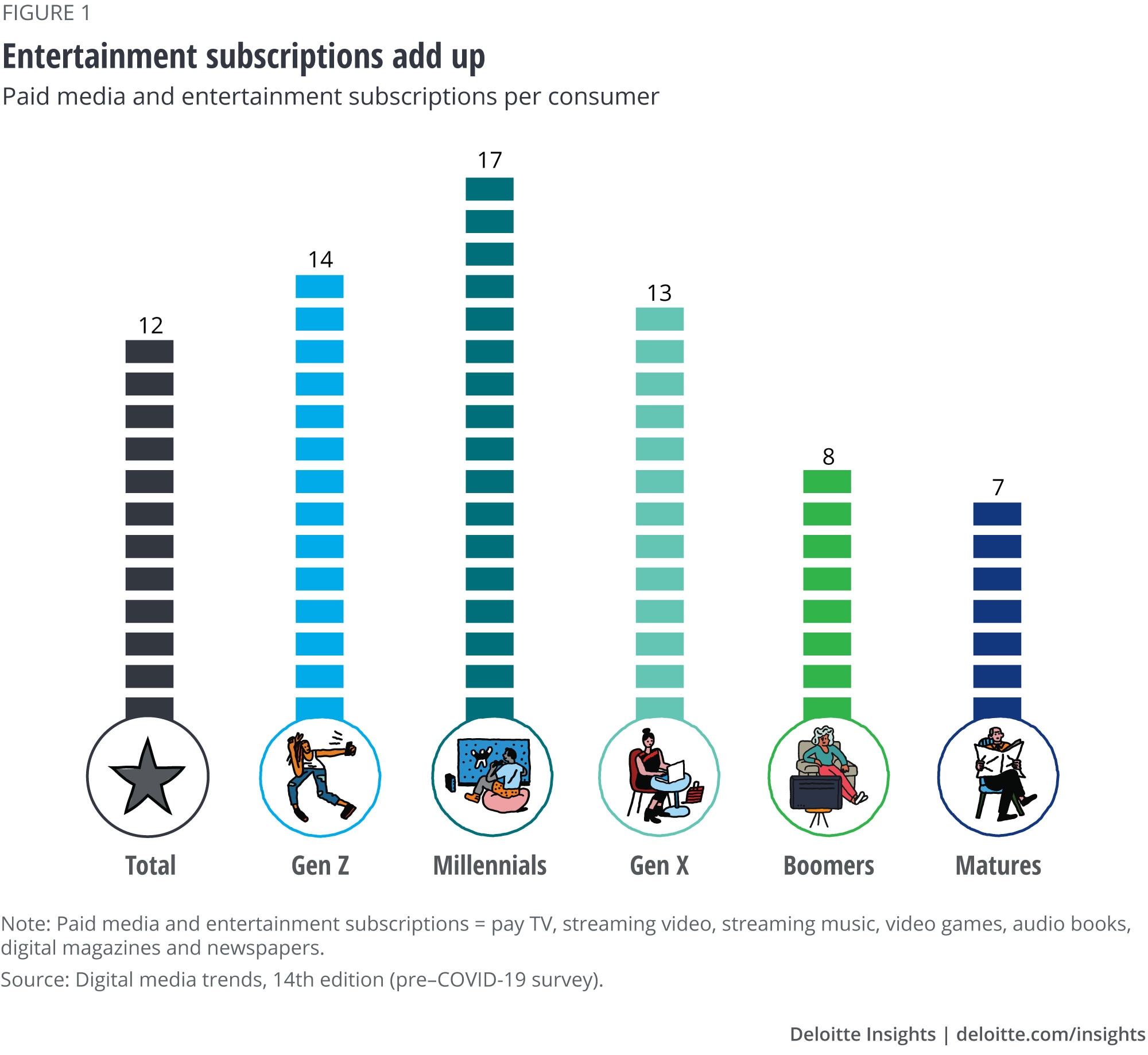
Our pre–COVID-19 survey also found that subscription fatigue was adding up. Consumers were juggling more costs and content, with a strong correlation between feeling fatigued and the desire to reduce subscription services (figure 2).
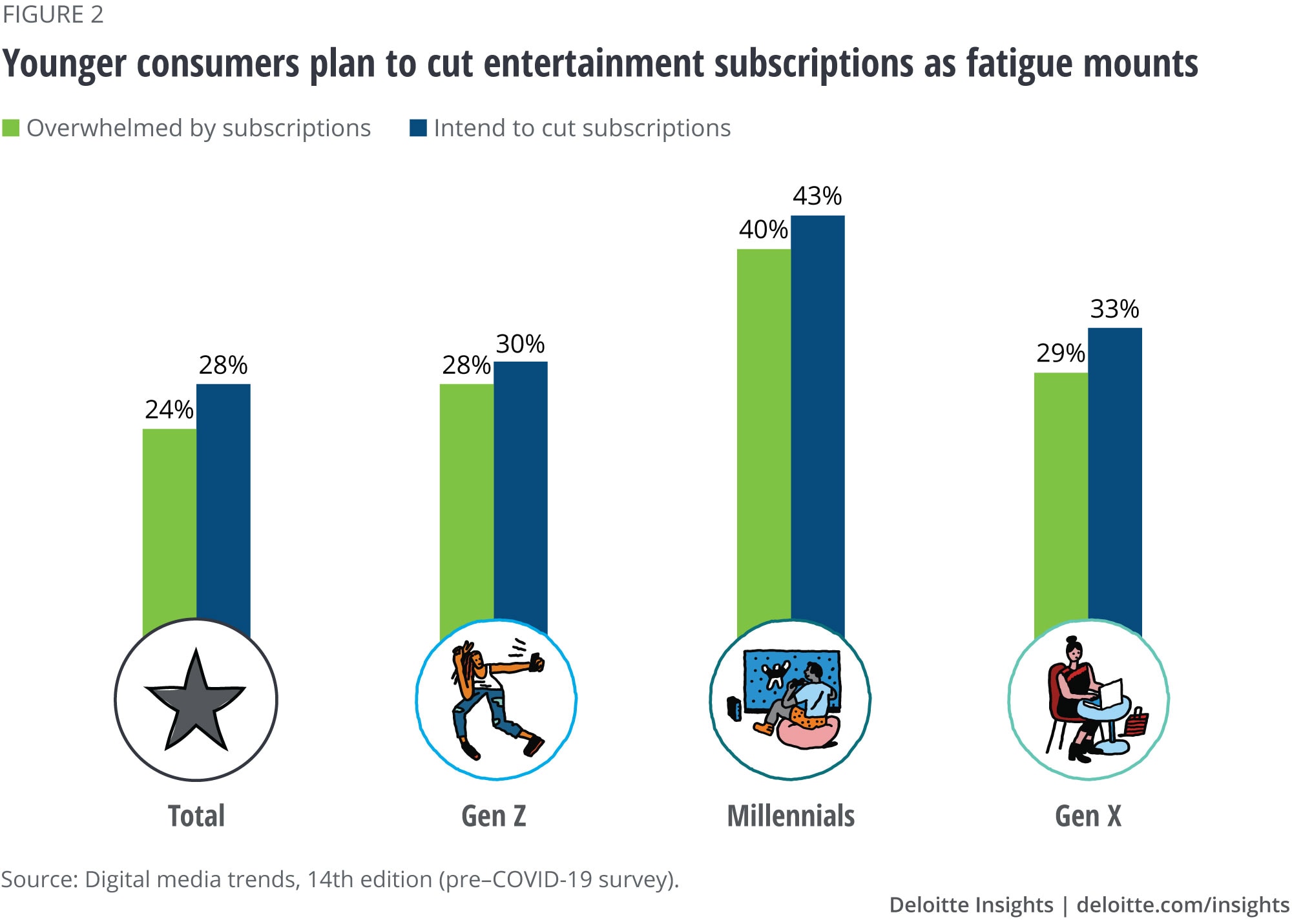
Among Millennials, 40% felt “overwhelmed” by the number of subscriptions they manage, and 43% intended to reduce them. For Gen Z and Gen X, these numbers hovered around 30%, suggesting that many consumers have signed up for more services than they can handle or afford. For providers, customer churn may become a growing problem.
Since the COVID-19 pandemic began, consumers we surveyed have been adding and cancelling subscriptions (figure 3). For example, 20% of US consumers made changes to their streaming music subscriptions: 12% added at least one service, 5% cancelled at least one, and 3% added some and cancelled others.

Streaming video subscriptions: After a giant leap, a step back?
The trend of additions and cancellations, both before and since COVID-19, becomes clearer when we examine streaming video subscriptions. Additions take center stage. In our pre–COVID-19 survey, 27% of US consumers said they had planned to add a new streaming video service in the coming year. Since the COVID-19 pandemic began, 23% have added at least one new paid streaming video service.
With this leap, 80% of US consumers now subscribe to at least one paid streaming video service (figure 4), up from 73% in our pre–COVID-19 survey. In what may be a lagging indicator of the shift to streaming, nearly 70% of Boomers now have a paid streaming video subscription.

Subscribers now have an average of four paid streaming video subscriptions, up from three in our pre–COVID-19 survey. Not only do more consumers have streaming video services, the average streamer pays for more services than ever. However, as more media providers join the fray—including Disney+, Apple TV+,6 and HBO Max—competition is growing and putting pressure on content and pricing. Since the COVID-19 pandemic began, 9% of consumers have both added and cancelled at least one new paid streaming video service, suggesting more churn as consumers seek value.
Additionally, when COVID-19 restrictions are lifted, consumers may reduce their subscriptions. We found that the top reason consumers added a streaming video service during the crisis was having more time to watch shows and movies. As consumers return to more normal routines, they may likely have less time for entertainment.
Bite-sized rates build subscriber bases—but for how long?
To win subscribers rapidly, many streaming video services are offering low introductory rates and free trials. But with cheap trials and easy cancellations, consumers can binge watch their favorite shows, cancel the subscription, and then return when the next season drops—essentially, “renting” services instead of joining them.
With cheap trials and easy cancellations, consumers can binge watch their favorite shows, cancel the subscription, and then return when the next season drops—essentially, “renting” the services instead of joining them.
This underscores the difficulty providers face with retention, as well as their growing focus on content libraries and original programming. When we asked consumers why they subscribed to a specific streaming video service, their answers revealed that content is still king.7 Consumers are drawn to streaming video services that offer a broad range of shows and movies and content they can’t get anywhere else—both originals and old favorites (figure 5).
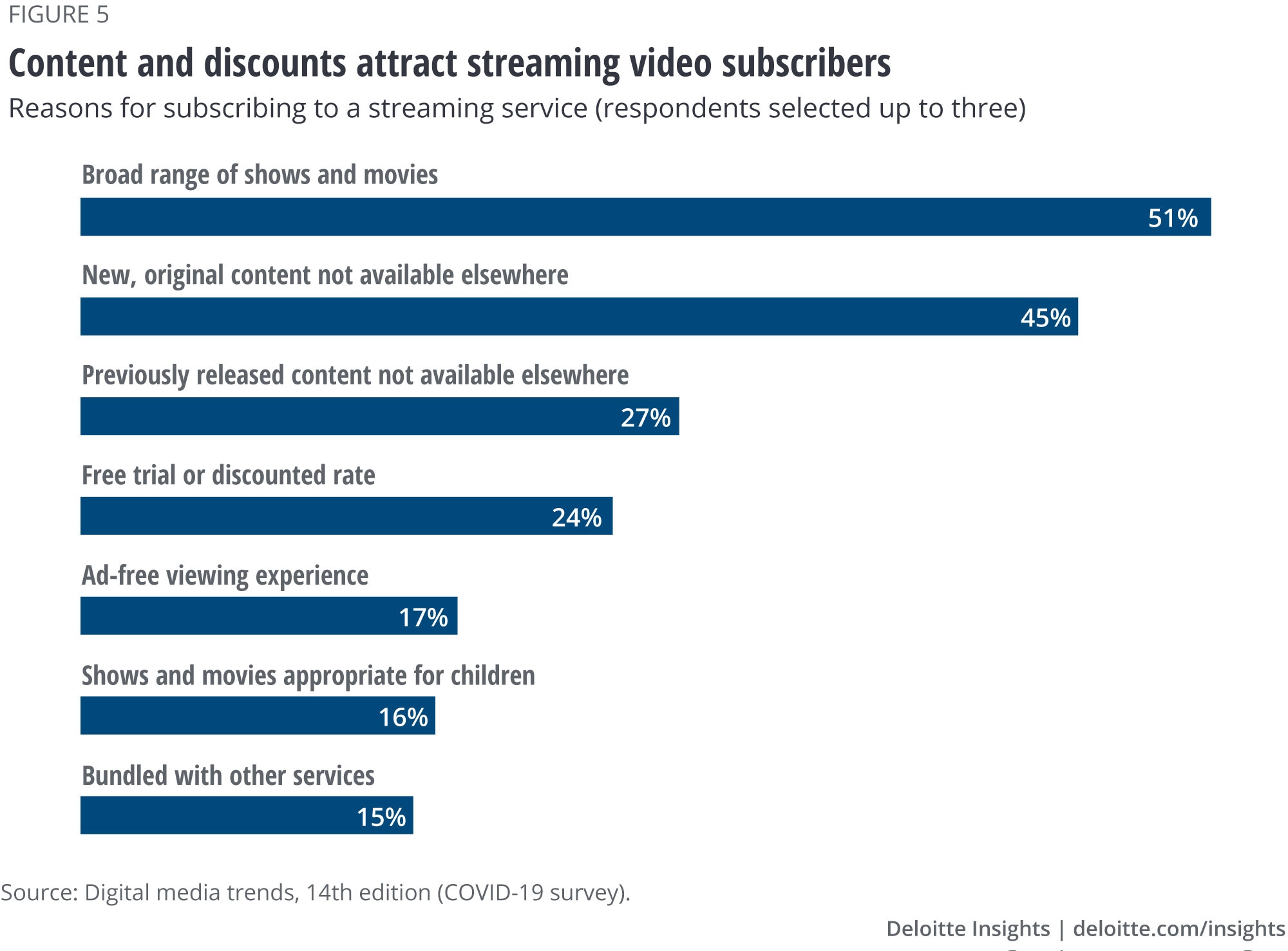
However, cost is also important. For nearly one-quarter of consumers, a free or discounted rate was a big factor in choosing a paid streaming video service. To decide if they should keep the service once the full price kicks in, consumers will likely evaluate whether it delivers enough high-quality content for the new price. Indeed, streaming video subscribers are cancelling more services: Our pre–COVID-19 survey found that 20% of subscribers cancelled at least one streaming video service in the previous year. In just a few months since COVID-19 began, 17% of subscribers cancelled a service. When we asked consumers why they cancelled, 36% said it was too expensive (figure 6). The crisis may be accelerating cost pressures. Consumers who lost income during the COVID-19 pandemic were more than twice as likely to cancel a service because of cost compared to those whose income was unchanged.

After cost, subscribers are cancelling because their trial ended, and/or they were done watching the content they signed up for. Even before the crisis, 38% of US consumers were binge watching weekly for an average of 4.2 hours per session. Since many productions have shut down during the crisis, providers face even greater pressure to retain audiences with great content. If consumers don’t get lasting entertainment for their money, they will cancel and move on to the next option.
Ad-supported streaming: Battle of the business models
In Asia, ad-supported streaming services dominate. More than 1 billion people watch free or ad-supported streaming video.8 In the United States, services have leaned toward premium monthly subscriptions with no ads. This could be changing. In our COVID-19 survey, 47% of US consumers currently use at least one free ad-supported streaming video service. Both before and since the COVID-19 pandemic, our surveys show that more US consumers want cheaper, ad-supported streaming video options (figure 7).
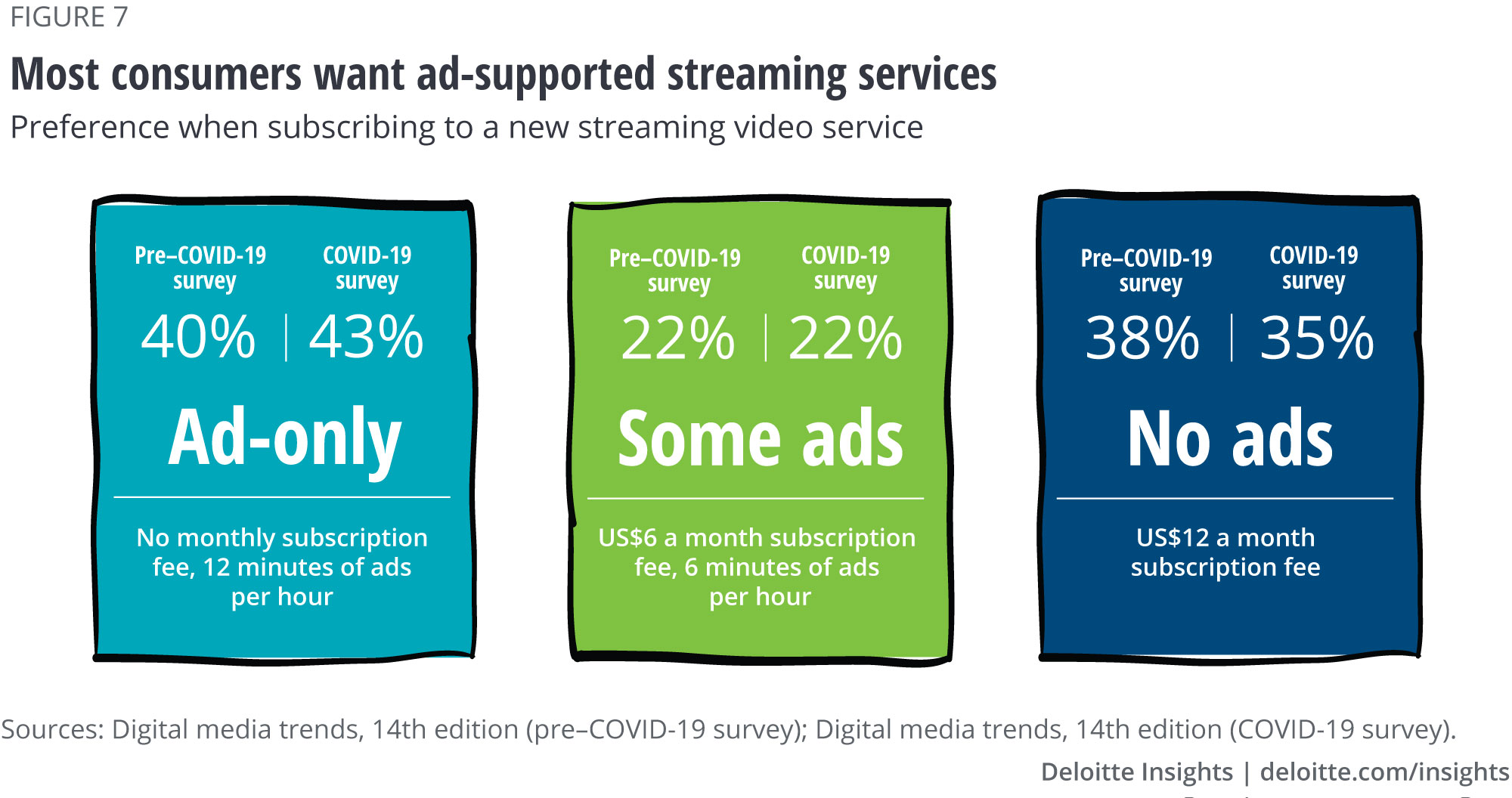
Our COVID-19 survey also found that 35% of consumers don’t want ads and will pay to avoid them. For these consumers, an ad-free experience is a big reason they watch streaming video services. There was no statistical difference between consumers who had lost income since the start of the COVID-19 pandemic and those whose incomes remained stable. The biggest difference was generational. Gen Z and Millennials were more likely than other generations to prefer the subscription-only model they grew up with, while Boomers and Matures preferred the ad-only option that closely resembles TV. However, all consumers have an ad tolerance of between seven and 14 minutes per hour. After that, they tune out.
Ad-supported options can help streaming video services appeal to a broad range of viewers. Given the escalating cost of producing original TV series9—up to US$25 million per episode—and exclusive streaming rights for sports leagues, streaming services may need to combine subscriptions and ads for “ultra-premium” content to make the numbers work.
Ad-supported options can help streaming video services appeal to a broad range of viewers.
Growth in video gaming expands during the crisis
Before the COVID-19 crisis, video gaming and related content were already growing in popularity and competing for more media and entertainment time. Generational lines were blurring with more people filling idle time playing mobile games and bingeing on gameplay in highly immersive and social worlds.
But there’s still a strong generational story. Before COVID-19, 24% of respondents listed playing video games among their top three favorite entertainment activities. But for Gen Z and Millennials, it was 44% and 37%, respectively. These younger participants have had some form of video gaming available most or all their lives.

As we’ve seen with on-demand video, more consumers binge on video games. Our pre–COVID-19 survey found that 29% of consumers were binge gaming weekly, for an average of 3.3 hours per session. Again, the generational story shines through, especially with digital natives: 52% of Gen Z and 46% of Millennials said they binge game weekly (figure 8).
Since the onset of the crisis, video gaming activities have accelerated considerably—up to 75% by some measures.10 In our COVID-19 survey, 29% of US consumers say they are more likely to use their free time to play a video game than watch a video. Of all consumers, 7% subscribed to a video gaming service for the first time during the crisis. We also found that nearly one-half of US consumers have participated in some form of video gaming activity since the crisis began. For Millennials, it’s 69%, and for Gen Z, it’s 75%.
School closures, shelter-in-place guidelines, and rising unemployment have given more people more time to engage with video gaming content. Among those participating in video gaming activities during the crisis, 34% are playing video games at home with their families a lot more, and 27% are playing to socially connect with others (figure 9). Notably, a third of U.S. consumers and nearly half of Gen Z and Millennials say that video games helped them get through a difficult time.
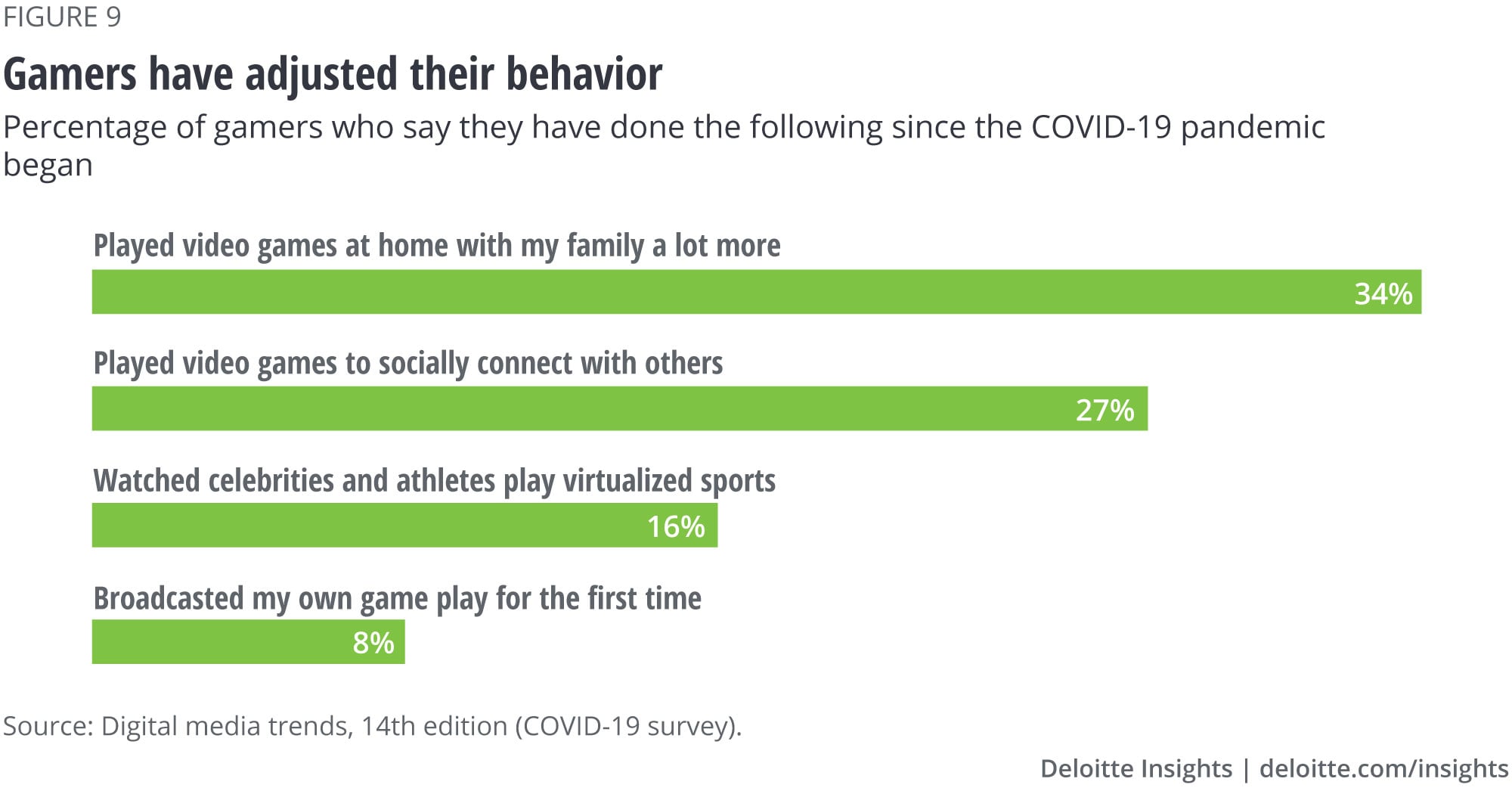
Video gaming has become a social experience, with top multiplayer titles hosting millions of players simultaneously and introducing very popular nongaming live events.11 As more kids and teenagers embrace video gaming, their parents are being drawn in as well. These activities will likely endure past the COVID-19 crisis. And yet, as people return to public events, commuting to work, and full employment, they may have less time to engage with video gaming experiences and content.
More people are watching video game content
With the rise of video and social streaming platforms, video gaming has also become a viewing experience. Prior to COVID-19, about 25% of consumers watched livestreamed and recorded video of others playing games each week. For Millennials and Gen Z, it was around 50%. Since the COVID-19 pandemic began, these numbers have held strong. Audiences mainly watch how-to videos and game walk-throughs, professional gamers and athletes livestreaming their play, and esports competitions. With the cancellation of live sports, many professional athletes have stayed connected with fans by streaming and commenting on their own video game play.12 Indeed, esports have enabled traditional sports such as basketball and racing to stay in the game virtually, despite the crisis.13
The top livestreaming service for gaming has seen 50% growth in hours watched during the pandemic.14 For both watching and playing games, it remains to be seen how much of this growth will sustain after lockdowns are lifted. And yet the phenomenon of playing, streaming, watching, and socializing in and around video games will likely continue to expand after the crisis has passed.
What will stay and what will go?
The pandemic has created conditions and opportunities for people to try new things, but will these new interests fade? Or are we seeing the beginnings of new markets? During the pandemic, 38% of consumers surveyed have tried a new digital activity or subscription for the first time. The most popular are viewing livestreamed events and watching video with others through a social platform, web application, or videoconference. More than two-thirds said they are likely to continue their new activity or subscription. Media and entertainment companies may not have anticipated that videoconferencing could be a new form of content, but these are times of great change.
Indeed, the crisis has also accelerated the debate around theatrical releases. With theaters closed, several studios have successfully released new movies directly to streaming video services.15 During the pandemic, 22% of surveyed consumers—30% of Gen Z and 36% of Millennials—paid to watch a first-run movie on a streaming video service. Of those who did, 90% said they would likely do so again. Of those who didn’t, 42% said it was too expensive. Studios may need to reevaluate their distribution models while tinkering with pricing for first-run streaming releases. While some people may be eager to return to the experience of big-screen theaters, others enjoy the comfort and convenience of home viewing. Obviously, COVID-19 has shifted this calculus and it remains to be seen how crowds will return to shared spaces.

Sports and live events have been hugely impacted by the pandemic. It is unclear when it will be safe to gather in large groups, or how willing people will be to do so once it is. We found that more than one-third of consumers said they wouldn’t be comfortable for more than six months when it comes to going to live events.16 This is just a snapshot in time, but it underscores the public’s anxiety and uncertainty. Notably, 50% of Millennials would be willing to attend a sporting event in the next six months, compared with just 28% of Boomers (figure 10).
With no new live sports to watch during the pandemic, many fans are going elsewhere—46% of respondents who are sports viewers are watching their favorite shows and movies, and 11% have been watching virtualized sporting events. Many sports and auto racing leagues have broadcast some sort of competition in a simulation of their sport.17 Perhaps unsurprisingly, virtual sports are becoming even more popular with Millennials: 19% are watching.
More broadly, live entertainment has become a stark example of both the impact of the crisis and the evolving—and possibly accelerating—blending of the physical and the digital. Over the course of Digital media trends survey, the arc continues: More experiences are being delivered through digital and virtual services, and people have become more empowered to find value on their own terms. The shock of COVID-19 has shaken foundations that were resistant to change. But it has also revealed new opportunities and led to innovations that media and entertainment companies may have resisted before.
Navigating the future of media and entertainment: The big questions
Before the COVID-19 pandemic, streaming video was continuing to expand across all generations, driving greater competition around content libraries, original content production, and pricing. More consumers were sampling, subscribing, cancelling, and even resubscribing as they chased content, enjoyed trials, and tested for value across a growing array of media and entertainment options. During the COVID-19 pandemic, most of these conditions have continued or accelerated. Yet auguring the future requires media and entertainment companies to work through difficult questions about the course of the pandemic, the time and money available to consumers, the growing array of options competing for their attention, the challenges imposed on media productions, and the need to reboot live entertainment.
M&E leaders can take this unprecedented moment to reevaluate everything about their businesses. Here are some key questions to explore:
- How can service providers retain customers and prevent churn once trials expire?
- How will consumers adapt to lost income and lower pay if the economic recovery is slow? Will they cut paid services and move to free options?
- How will ad-supported models evolve as consumers demand more pricing options?
- What happens if the content pipeline for original content is stalled for too long? Will consumer churn accelerate?
- How can studio productions and live entertainment reboot and return to business? Can they better leverage technologies to engage with audiences and fans virtually while securing physicality?
- How much more entertainment time will consumers devote to video gaming and livestreaming services? Will virtualized sporting events become an artifact of the pandemic, or will leagues find ways to integrate them to drive more fan engagement?
- How will rising demand for content that is more social and more virtual potentially augment—or compete with—traditional video content?
Many media and entertainment companies have seen subscribers and users grow, both before and since COVID-19 hit. Entertainment has become more important than ever, as a solace in hard times and a way to spend time. Consumers have many options and less money to spend. M&E companies that can deliver the best value for money and time spent could lead for the next decade. Those that can’t will likely look upon this crisis as a missed opportunity.
© 2021. See Terms of Use for more information.
Explore the Technology collection
-
The most valued technology gadgets of the last decade Article5 years ago
-
TMT Predictions 2025 Article4 months ago
-
Rediscovering your identity Article5 years ago
-
A pragmatic pathway for redefining work Article5 years ago
-
Tech Trends 2025 Article4 months ago



















